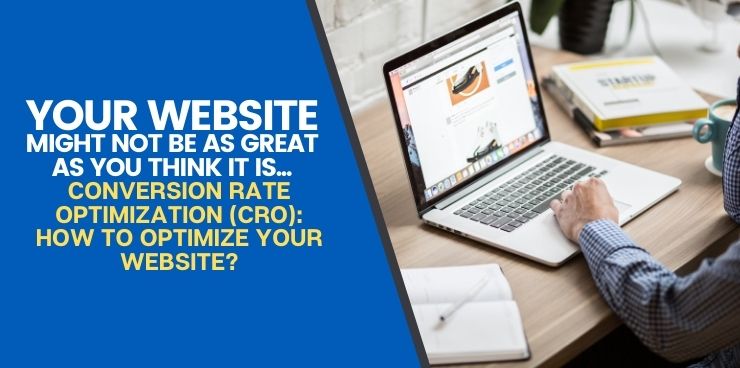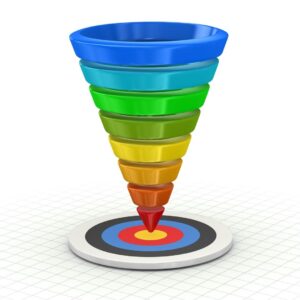What is Conversion Rate Optimization?
The path your buyer takes to you is their journey. Or as it is often called, their sales funnel.
This funnel or path has multiple stages, and at each stage, some potential buyers will drop off, while others will continue on to the next stage, inching closer to making a purchase.
These decision points have conversion rates associated with them, and the higher each rate is, the more sales you’ll convert.
Conversion Rate Optimization, or CRO, is a strategy that aims to maximize sales and lower the cost of customer acquisition by increasing conversion rates all along the way. The more customers that move on to the next step in the journey, the more customers you’ll have making purchases at the end.
Determining Your Starting Point
To determine the conversation rates you currently have, you need two data points.
1. Visitors, or how many people saw a piece of content.
2. Conversions, or how many people took the action that the content encouraged.
Your content should always aim to send your customer to the next step in your sales process, so if the content convinces a person to take that next step, then you’ve “converted” them.
The CRO formula is simple: divide visitors by conversions, and then multiple by 100 to get the conversion rate in a percentage.
For example, if 100 people land on your special offer page, and 10 people click through to the offer, then that step in your funnel has a 10% conversion rate.
 Determining Your Goals
Determining Your Goals
Your first goal should be to increase your conversion rate.
Once you’ve increased the rate, you can then set specific, measurable goals based on what you believe to be realistic.
Generally speaking, to determine the conversion rate you want to achieve, you can look to your competitors. Since each industry has a different conversion rate, you’ll want your goals to be industry-specific.
You might find your conversion rates are low for your own personal goals, for your industry, or for your competitors. Regardless of the reason, you can get to work with our guide to set and implement your conversion rate optimization strategy.
Where and How Can a CRO Strategy Be Implemented?
Since CRO is relevant at every step of the way, there will be many opportunities to implement CRO strategy. Anywhere your user will see your content, you can use principles of conversion rate optimization. For our purposes, we’re going to focus on website CRO.
Here are 5 examples of website pages that can be modified to maximize conversions for your business:
1. Homepage
The homepage is likely the most-visited page on your website. It’s also likely the first page any of your potential customers will see. That means you have the opportunity to make a good first impression in order to keep them coming back as well as keep them moving throughout your website.
It’s important to utilize this page to its full potential, which means maximizing the amount of content you can have before your users get overwhelmed or confused. You might not be able to have a chatbot, a free ebook download button, a newsletter sign up form, and a detailed description of your company. But you can maximize the potential of your traffic with this page by using the real estate effectively, which means drawing potential customers in with that good first impression.
2. Quote or Pricing Page
Pricing pages present their own unique challenge: altering the scope of the price can determine how your potential clients assess the cost of your product or service.
You can experiment with different pricing strategies to see if your users are more enticed by a monthly rate, a weekly rate, or no rate at all so that they have to contact you to find out. How you frame the worth of the product or service as it relates to the price will determine your conversion rate here.
3. Blog Page
Blogs offer valuable information to users for free, often in the hopes that they will be able to convert readers to customers. At the very least, blogs can help demonstrate your value to your customers, and increase the repeat traffic to your website. The more times a user returns, and the more they trust and appreciate your content and expertise, the higher your conversion rates will be.
4. Landing Pages
Landing pages are most effective when they present one action for users to take. They’re often called single action landing pages for this reason, and they’re an excellent opportunity to narrow down the scope of your content.
These landing pages are a good place for sign-up forms, registration opportunities, or free download offers. These pages are concentrated opportunities to focus on one aspect of your sales funnel to maximize your conversion rate optimization at that step.
5. Contact Us Page
This page is perhaps one of the most important single action landing pages you can have. The action you want them to take is to contact you, so it’s going to be one of the later steps in your funnel, and one of the most important. The further down the path you fail to convert a lead to a sale, the more expensive that loss of a conversion becomes.
You want users to reach your contact page after you’ve had the opportunity to demonstrate your understanding of their desires and proven your solution is effective for them. Or at least almost convinced them. This contact page can also be used to help convert stubborn leads, since you can engage with them directly to answer their questions or address their concerns.
If you’re struggling with any step of this process, we’re here to help. No matter what your needs are, we have diverse solutions to answer them. Visit our services page for more information.
CRO Expert Tips and Best Practices
Know Your Buyer’s Journey
With technology and digital marketing, though, that path or tunnel is looking less and less linear. This changing buyer experience is as fluid as technology itself. As digital resources evolve, the number of channels through which your customers find you evolves, too.
This evolution requires you to engage with your customers to understand their journeys. Only then will you be able to understand where and how to optimize your conversion rates.
Zero Moment of Truth
At the zero moment of truth, your user recognizes that they have a problem they ought to solve. They begin to search for a solution.
First Moment of Truth
At the first moment of truth, your user finds you, your services, and your products.They assess their desires and needs against your product and its cost, and they make a decision.
Second Moment of Truth
At the second moment of truth, your user has usually become a customer. Now they assess if your product or service was worth it for them, and if it solved their problem or addressed their need.
Third Moment of Truth
At the third moment of truth, your client decides to come back for repeat purchases or not. They decide if they’re a committed customer to your business.
Know What Your Market Actually Wants
By engaging with your clients via surveys, interviews, and other market research, you can trace out the different journeys they take and why.
Having a clear map of where they’re coming from and where they want to go will allow you to offer them the content they need at the right time to help them see that you’re the solution they need.
After you understand how they move through their pathways, you need to dig deep to discover why.
Desire drives conversions. By understanding what your customers want, you can tap into those desires to convince them that your product or service fulfills their needs. You can’t guess their desires, and you can’t use your own to infer theirs either. To get to know your customers, perform market research. Understand their tone, their words, and their language. Absorb it all, and then let it determine how you present your solutions to them.
Customer Relationships Come First
If your customers don’t trust you, then they won’t feel comfortable engaging with you.
By proving your worth to them, you’ll be able to build relationships that lead to improved conversion rate optimization in early steps. For example, by providing free informational or educational content, you can demonstrate your expertise to customers who will then begin to trust you and your services or products. This strong foundation will also keep customers coming back, and increasing the rate of repeat customers is going to be a huge boost for revenue.
Send a Clear Message
Each piece of content that your customer engages with should be narrowly-focused enough to ultimately have one takeaway with one next step.
Show them that you understand their desires, and then convince them you can fulfill those wants. If your pages have many different messages, or conflicting next steps, then conversions will suffer, and you won’t even be able to narrow down where exactly or why.
 Breadcrumbs
Breadcrumbs
When you analyze your sales funnel and identify the paths that users tend to take, you can organize your requests and offers to increase in gravity. You don’t want the first action you ask a user to take to be “Purchase Now!”
Do they know who you are and what you offer? Are they aware of their needs and desires?
By asking users to opt into small steps, such as providing an email address for a free download, you can slowly help them feel more comfortable. What you ask of them can increase in commitment level as they grow to trust you, so that when you finally ask them to make a purchase, it’s easier for them to say yes.
Optimize Content, Conduct Tests and Repeat
Once you perform market research, you’ll understand where your customers come from, how they get to you, and what they ultimately want. At that point, you’ll be able to craft your content to optimally meet their needs.
Once you feel you’ve optimized your content, you’ll need to track data to determine your conversion rates. Test your content, see what works and what doesn’t and then reformulate.
One type of test you can use is A/B testing. It will allow you to try different methods, messages, or pages against one another. For example, you can test how one landing page converts with one type of language, and then how another converts with a different type of language for the same offer. Direct half of your traffic to one page and half to the other, then compare results.
Your data will clearly show you your rates, but how you interpret them requires a deep understanding of your market. Why is that page converting so well?
In addition to inferring why a page might convert well or not, you can always go straight to the source. Ask your customers what their hold-ups are, or what convinced them. You can use polls, surveys, test groups, and more.
You can repeat this process ad infinitum, and your conversion rates should improve.
If they’re not improving, though, there’s another step you can take.
You can work with us. We’ll get started right away to optimize your conversions and improve your sales processes and figures.
Book a call with Selling Revolution today!


 Determining Your Goals
Determining Your Goals
 Breadcrumbs
Breadcrumbs